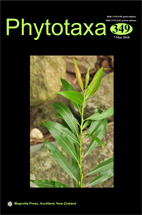Abstract
Teucrium Linnaeus (1753: 562), with about 250–260 species, is one of the largest genera of subfamily Ajugoideae, Lamiaceae (Li & Hedge 1994, Harley et al. 2004). The Mediterranean basin is the diversity center of this genus, where ca. 250 species are distributed (Harley et al. 2004, Ozcan et al. 2015). Teucrium can be easily distinguished from other members of Lamiaceae by a lack of corolla upper lip and nongynobasic style (Li & Hedge 1994, Ozcan et al. 2015). Recent phylogenetic research revealed that Teucrium was not monophyletic, as several small genera were nested within it, such as Teucridium Hooker (1853: 203), Spartothamnella Briquet (1895: 161) and Oncinocalyx Muelle (1883: 69) (Salmaki et al. 2016).

